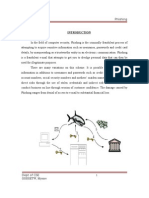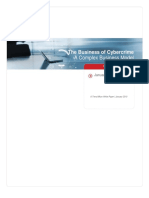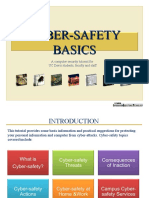BEC Scam Gift Card Scams
BEC Scam Gift Card Scams
Uploaded by
gbokoyiolusegunCopyright:
Available Formats
BEC Scam Gift Card Scams
BEC Scam Gift Card Scams
Uploaded by
gbokoyiolusegunCopyright
Available Formats
Share this document
Did you find this document useful?
Is this content inappropriate?
Copyright:
Available Formats
BEC Scam Gift Card Scams
BEC Scam Gift Card Scams
Uploaded by
gbokoyiolusegunCopyright:
Available Formats
https://www.forbes.
com/advisor/personal-
finance/gift-card-scams/
BEC Scam: Gift Card
Scams
Robert Jordan III Follow
Information Security
Leader & GRC nerd
Published Dec 13, 2023
Business Email Compromise (BEC) is a
common threat to businesses and
individuals that has totaled global losses
of at least $51B between 2013 to 2022.
There are a number of BEC scams that
impersonate CEO’s or executives at an
organization via social engineering with
the goal of financial gain through some
type of funds transfer such as wire
transfers, invoice payments, payroll, and
gift cards. In this article I highlight gift
card scams; what the scam is, how the
scam is designed and active measures
organizations can take to mitigate the
impact of this scam.
What Are Gift Card Scams?
Gift Card scams are another low risk / high
reward activity for cybercriminals. Low
risk as it’s difficult to trace the activity and
easy to perform at scale (hundreds of
thousands of emails messages delivered
to thousands of companies). High reward
as there have been $1.9M of reported
losses in Gift Card or Gift Card Reloading
scams in the first three quarters of
2023.
Like other BEC scams, Gift Card scams
start with a phishing email or a text
message to an employee's personal
phone. A simple email posing as the CEO
or other executive at the company to an
employee if they can assist with a quick
task. The task is to purchase some gift
cards and send the card numbers on the
back. The messages are often time
sensitive which pressure the recipient to
act quickly. This scam preys on those
employees that want to be helpful.
How the scam is designed
The cybercriminals will start by scrapping
names and titles from LinkedIn and cross
referencing this with other known breach
data to gather email addresses and phone
numbers for an organization. They can
often buy lists of this data as well. These
lists will be reused for a number of BEC
scams.
Once armed with names, titles, phone
numbers and emails, the cybercriminals
will spam employees directly at a company
attempting to get a reply. The criminals will
use several free mail services to send their
mail from (gmail.com; icloud.com; mail.ru
etc), though most will originate from
Gmail. In some cases they will create a
new domain for their campaign. In more
sophisticated cases, they will create a
look-a-like domain using typosquatting
techniques.
They often target employees who are new
to the company or have a recent job title
change at LinkedIn. The assumption here
is that new employees are more likely to
be helpful. When texting, they will often
deliver the message late on a Friday or
over the weekend.
The messages are often sent to more than
just one person within the organization in
the hopes that one will reply. Should the
cybercriminals receive a reply, the
cybercriminals give some reason to need a
gift; for a client; for other employees; to
help a sick child. They request the
employee to immediately go to a local
store and purchase multiple types of gift
cards and send the codes from the back
of the card.
The messages may also move from email
to another messaging system, such as text
message or WhatsApp. This hides the
conversation from security teams at
companies. The messages will often
state that the employee will be reimbursed
for their effort, sometimes with interest.
Once the codes are delivered, the
cybercriminals pull the funds off the
cards. Stolen funds are often not
recovered after the scam is discovered.
How the scam looks
The first email is often just a few lines.
The email name will impersonate the CEO,
in this case Bob, but the email will come
from outside the company, often from
gmail.
https://usa.kaspersky.com/blog/what-is-bec-
attack/21158/
The email could also jump to another
communication channel such as this
example.
https://www.thesslstore.com/blog/how-to-spot-
protect-against-business-email-compromise-bec-
attacks/
Once the employee replies, the criminal
requests that the employee obtains the
gift cards urgently.
https://www.proofpoint.com/us/blog/threat-
protection/understanding-bec-scams-gift-card-
scams
Here is what the scam may look like as a
text message to an employee's personal
phone. The cybercriminals take this route
as it can bypass many protections that are
set for corporate email.
https://cofense.com/blog/bec-ceo-gift-card-scams/
Ways to detect and prevent gift card scams
People often hold the recipient of the
message responsible as they should
carefully check the message for telltale
signs of a scam, but I do not agree. Putting
the responsibility solely on the recipient is
inappropriate and will often fail. Here are
some additional controls to help prevent
and detect this scam.
Alert and educate your company about
this scam. State that no executive will
ever ask for gift cards. Ensure this is
highlighted on Day 1 training.
Have a defined procedure on how to report
suspicious emails or text messages.
Encourage your employees to use this
procedure often.
Purchase and park look-a-like domain
names to prevent criminals from using
them against you.
Email logs should be sent to a SIEM or log
aggregator. Alerts should be triggered for
email spoofing (mails that look like they
are from the company but are sent from
outside mail systems).
Add a secure email gateway that looks and
blocks multiple types of BEC; alerts when
messages are received from domains that
were recently created; alerts for spoofing.
Enable the “external email warning” banner
to emails.
Ensure email accounts are protected by
Multi-Factor authentication to reduce the
risk of account takeovers.
Recovering from Gift Card Scam
The company should reimburse the
employee for the loss. The security team
should create and document the incident
following your Incident Response
processes. In most cases, the financial
loss can not be recovered and is
immaterial to claim. However, you should
report the incident to your cyber insurance
carrier as a non-claim report.
Add a comment...
More articles by this author
Crypto Investment Scams Periodically ch
Feb 14, 2024 air filters and o
controls
Dec 28, 2023
See all
Insights from the community
E-commerce
How can you protect your online payments?
Consumer Electronics
How do you avoid scams and frauds when
shopping for electronics online?
Payment Systems
How can you protect your personal and
financial information when making online
payments?
E-commerce
What's the best fraud prevention tool for
your e-commerce site?
E-commerce
How do you inform customers of e-
commerce fraud?
Financial Services
How do you spot and stop card-not-
present fraud in e-commerce?
Show more
Others also viewed
Business Email Compromise -
Gift Card Scams
Rachel Ewart · 3y
No Shame Security
Stephen Semmelroth · 3y
Gift Card Millionaires: The Grey
Area of Cyber Fraud
Mobolaji "Manny" Moyosore · 4y
App store gift card scam,
shouldn’t Apple undertake
Corporate Social Responsibility
(CSR)?
Livia . · 3y
How to identify a scam email
Marco Tapia · 4y
BEWARE OF HOLIDAY
SCAM
Jeannine Keen, MS · 5y
Show more
Explore topics
Sales
Marketing
Business Administration
HR Management
Content Management
Engineering
Soft Skills
See All
Like Comment Share
You might also like
- NSE2 Sandbox - Quiz Attempt ReviewDocument2 pagesNSE2 Sandbox - Quiz Attempt Reviewking jumper34350% (2)
- CompTIA Security+ Cheat SheetDocument12 pagesCompTIA Security+ Cheat Sheetsharaf jaber100% (5)
- Phishing-WPS OfficeDocument13 pagesPhishing-WPS OfficeAlyana SweetyNo ratings yet
- Ethical Issues in E-CommerceDocument15 pagesEthical Issues in E-CommerceKrishna IyerNo ratings yet
- Don't Be A Target of Phishing AttacksDocument2 pagesDon't Be A Target of Phishing AttacksnytpproNo ratings yet
- Phishing AwarenessDocument5 pagesPhishing AwarenessStanley AnyanwuNo ratings yet
- Don't Step in the Trap: How to Recognize and Avoid Email Phishing ScamsFrom EverandDon't Step in the Trap: How to Recognize and Avoid Email Phishing ScamsNo ratings yet
- 0 Aiet/Cse/Seminar On It ActDocument30 pages0 Aiet/Cse/Seminar On It ActAmber Choudahry0% (1)
- Cyber Security Unit 3Document27 pagesCyber Security Unit 3Nithi MiniNo ratings yet
- 1 - Enterprise Network Protection Against Cyberattacks Primer: Business Email CompromiseDocument9 pages1 - Enterprise Network Protection Against Cyberattacks Primer: Business Email Compromisedenny tobingNo ratings yet
- Phishing PDDocument22 pagesPhishing PDAyush DargarNo ratings yet
- Phishing Seminar ReportDocument27 pagesPhishing Seminar ReportsanjayNo ratings yet
- Application of Deep Learning in Fraud DetectionDocument5 pagesApplication of Deep Learning in Fraud DetectionJetarita Njeri GathituNo ratings yet
- Securing Your Digital Life, Part Two - The Bigger Picture and Special CircumstancesDocument13 pagesSecuring Your Digital Life, Part Two - The Bigger Picture and Special Circumstancesxzn2p3No ratings yet
- Module 3 Final LITERA (Activity 2)Document4 pagesModule 3 Final LITERA (Activity 2)Chloedy Rose SaysonNo ratings yet
- Phishing FAQDocument4 pagesPhishing FAQDeanNo ratings yet
- Seminar of Internet Security LawDocument21 pagesSeminar of Internet Security Lawpintu ramNo ratings yet
- How Can I Protect Myself From Online Payment Fraud?Document3 pagesHow Can I Protect Myself From Online Payment Fraud?stephaniewaters1212No ratings yet
- Phishing Seminar ReportDocument27 pagesPhishing Seminar Reportvijayalakshmilakshmi100% (1)
- Fraud FC 6 - Impersonation ScamsDocument3 pagesFraud FC 6 - Impersonation Scamslu387315No ratings yet
- Technically Speaking Spring 2014Document5 pagesTechnically Speaking Spring 2014api-219290961No ratings yet
- GR5 - Principles of Information SecurityDocument11 pagesGR5 - Principles of Information SecurityVân Anh TrầnNo ratings yet
- Unit 5 1Document6 pagesUnit 5 1anjanesh mauryaNo ratings yet
- Wk7 Case5 TechnologyDocument2 pagesWk7 Case5 TechnologyShehryar KhanNo ratings yet
- Comptia Sy0701b 2 2 1 Business Email Compromise - v2 UD011124Document2 pagesComptia Sy0701b 2 2 1 Business Email Compromise - v2 UD011124dummymail.askew545No ratings yet
- Playbooks-Mitigation of Phishing CampaignsDocument6 pagesPlaybooks-Mitigation of Phishing CampaignsLudwig Geoffrey100% (1)
- Cyber Security and Digital Risk Management 1Draft-P 952022Document13 pagesCyber Security and Digital Risk Management 1Draft-P 952022sandyena benyoussefNo ratings yet
- Internet FraudDocument17 pagesInternet FraudVidyadhara HegdeNo ratings yet
- cyber security -LAB RECORD - SEM-IIIDocument19 pagescyber security -LAB RECORD - SEM-IIIArvind KNo ratings yet
- IL-midterm - en Sreynich - G3Document8 pagesIL-midterm - en Sreynich - G3សុខ សុវណ្ណារ៉ា៚No ratings yet
- Cyber Security Lab RecordDocument14 pagesCyber Security Lab Recordvignesh033No ratings yet
- Protecting Against Compromised Email Accounts WP 230111.cleanedDocument11 pagesProtecting Against Compromised Email Accounts WP 230111.cleanedtavorodriguezNo ratings yet
- Hidemyacc - How to Hide Your Online Accounts A Step-by-Step Guide to Protecting Your Digital IdentityFrom EverandHidemyacc - How to Hide Your Online Accounts A Step-by-Step Guide to Protecting Your Digital IdentityNo ratings yet
- Digital Citizenship Lesson 3Document7 pagesDigital Citizenship Lesson 3api-239509004No ratings yet
- Protect Your PC - 1Document8 pagesProtect Your PC - 1manicheeseNo ratings yet
- Spam DetectionDocument6 pagesSpam Detectionalphain69No ratings yet
- CIS1290 SMEPresentation Ellis LoganDocument7 pagesCIS1290 SMEPresentation Ellis LoganLogan EllisNo ratings yet
- CSNC Final PrepDocument7 pagesCSNC Final PrepMoiz HussainNo ratings yet
- Caltejuliana Digital Citizenship Lesson 3Document7 pagesCaltejuliana Digital Citizenship Lesson 3api-239211236No ratings yet
- Cyber Law - NotesDocument2 pagesCyber Law - NotesKaran VyasNo ratings yet
- E Commerce AssignDocument4 pagesE Commerce AssignMargo ShaezNo ratings yet
- How to Do Bec Phishing Attack(1)(1)Document13 pagesHow to Do Bec Phishing Attack(1)(1)aslanbeyaaz2No ratings yet
- Topic 6 Online SecurityDocument47 pagesTopic 6 Online SecurityTamil ArasuNo ratings yet
- Delelon Andrea Digital Citizenship Lesson 3Document7 pagesDelelon Andrea Digital Citizenship Lesson 3api-239211250No ratings yet
- Assignment 5.2Document3 pagesAssignment 5.2NICOLE YHNA LAGUISMANo ratings yet
- Phishing Case StudyDocument5 pagesPhishing Case StudyKamatchi KartheebanNo ratings yet
- Charli Rodriguez Lesson 3 Digital CitizenshipDocument7 pagesCharli Rodriguez Lesson 3 Digital Citizenshipapi-239279571No ratings yet
- Pedro Huertaigital Citizenship Lesson 3Document7 pagesPedro Huertaigital Citizenship Lesson 3api-239203613No ratings yet
- Aditya Sharma - Yatendra SirDocument15 pagesAditya Sharma - Yatendra SirAditya SharmaNo ratings yet
- 6-Digital Postmaster and Email ScamsDocument29 pages6-Digital Postmaster and Email Scamschobiipiggy26No ratings yet
- Leonel Castro DC Lesson 3Document7 pagesLeonel Castro DC Lesson 3api-246735981No ratings yet
- Jose Reyes Digital Citizenship Lesson 3Document7 pagesJose Reyes Digital Citizenship Lesson 3api-239451754No ratings yet
- Phishing 3371Document10 pagesPhishing 3371Syafiq RiderNo ratings yet
- CSE Phishing ReportDocument37 pagesCSE Phishing ReportMuhammedYeshawNo ratings yet
- Garciajackie Digital Citizenship Lesson 3Document7 pagesGarciajackie Digital Citizenship Lesson 3api-239502259No ratings yet
- Identity Theft KitDocument17 pagesIdentity Theft KitcorpNo ratings yet
- HSBC Fraud Guide - HSBC Bank PLCDocument9 pagesHSBC Fraud Guide - HSBC Bank PLCsampaio2710No ratings yet
- Information Security Cybersecurity Final ProjectDocument8 pagesInformation Security Cybersecurity Final Projectapi-541116146No ratings yet
- Monroy Roderick Digital Citizenship Lesson 3Document7 pagesMonroy Roderick Digital Citizenship Lesson 3api-239211248No ratings yet
- Digital Citizenship Lesson 3Document7 pagesDigital Citizenship Lesson 3api-239502285No ratings yet
- Juan Garcia Digital Citizenship Lesson 3Document7 pagesJuan Garcia Digital Citizenship Lesson 3api-239502436No ratings yet
- The Business of Cybercrime: A Complex Business ModelDocument15 pagesThe Business of Cybercrime: A Complex Business ModelAdi ProphecyNo ratings yet
- Introduction To Cybersecurity v2 EOC Assessment - Final Exam AnswersDocument10 pagesIntroduction To Cybersecurity v2 EOC Assessment - Final Exam AnswersEnvy VoiceNo ratings yet
- The Cybersecurity Providers Next Opportunity Making Ai SaferDocument13 pagesThe Cybersecurity Providers Next Opportunity Making Ai Safersam dhaiyaNo ratings yet
- Computer and Internet CrimesDocument30 pagesComputer and Internet Crimesms.krisabelNo ratings yet
- Hacking For BeginnersDocument155 pagesHacking For Beginnersahmed caydiid100% (1)
- CRNS Notes Unit I To VDocument183 pagesCRNS Notes Unit I To VAswini LayaNo ratings yet
- PasswordDocument4 pagesPasswordevx41611No ratings yet
- STRIDE/DREAD Analysis: Threat Modelling of Trinity WalletDocument24 pagesSTRIDE/DREAD Analysis: Threat Modelling of Trinity WalletSheloqNo ratings yet
- IBM Security Verify Privilege Level 2 Quiz Attempt ReviewDocument15 pagesIBM Security Verify Privilege Level 2 Quiz Attempt ReviewLyu SeyNo ratings yet
- Fresh Grad, 23, Admits Hacking Comelec Site: Leading To The Biggest LeakDocument4 pagesFresh Grad, 23, Admits Hacking Comelec Site: Leading To The Biggest LeakLousette CunananNo ratings yet
- Carding From Dell-1Document2 pagesCarding From Dell-1BADBOY BRETNo ratings yet
- Chapter 4 - Version1Document113 pagesChapter 4 - Version1raxhelammNo ratings yet
- 0290 Cyber Safety Basics TutorialDocument23 pages0290 Cyber Safety Basics TutorialJohn NjinjuNo ratings yet
- Web Application Security CourseDocument2 pagesWeb Application Security Courseankit CyberNo ratings yet
- Cyber Crimes in MalaysiaDocument13 pagesCyber Crimes in MalaysiaNoorazian Noordin100% (3)
- Chapter 10 - Securing The Web Environment: at A GlanceDocument9 pagesChapter 10 - Securing The Web Environment: at A Glanceghar_dashNo ratings yet
- Session 3.4 - Cyber Security RiskDocument48 pagesSession 3.4 - Cyber Security RiskhvanhtuanNo ratings yet
- ISM - September 2022 Changes (September 2022)Document4 pagesISM - September 2022 Changes (September 2022)FrancineMNo ratings yet
- Cryptography and Network Security Chapter 22 Chapter 20 - FirewallsDocument5 pagesCryptography and Network Security Chapter 22 Chapter 20 - FirewallsPrasannaBhagavathNo ratings yet
- Security Guide For ABAP DevelopersDocument12 pagesSecurity Guide For ABAP DevelopersMaxNo ratings yet
- Chapter 04 - Network SecurityDocument25 pagesChapter 04 - Network SecurityJaye 99No ratings yet
- Patterns of Development: Paul Christian Reforsado AbadDocument55 pagesPatterns of Development: Paul Christian Reforsado AbadCharmaine Asong100% (1)
- Security Concepts BOOKDocument9 pagesSecurity Concepts BOOKNikos NikouNo ratings yet
- CCS343 - Digital and Mobile Forensics Anna UniversityDocument89 pagesCCS343 - Digital and Mobile Forensics Anna Universitycodehomies100% (1)
- The First Security Engineer's 100-Day ChecklistDocument21 pagesThe First Security Engineer's 100-Day ChecklistIvan PopovNo ratings yet
- Tagi 01 PerimeterandexternalnetworkDocument6 pagesTagi 01 Perimeterandexternalnetworkapi-264934413No ratings yet
- Chapter 04Document30 pagesChapter 04Fatima AlshareefNo ratings yet
- Advantages of ComputerDocument2 pagesAdvantages of ComputerBlessing EyekaNo ratings yet

























































































